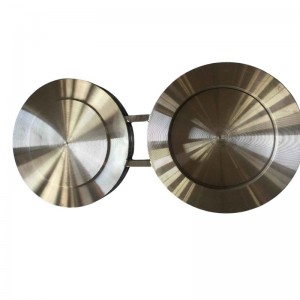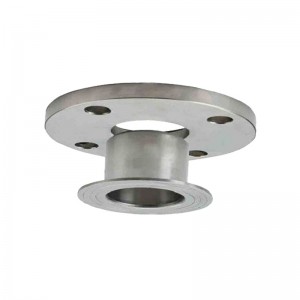SPECIFIKIM
| Emri i produktit | Lidhje me mbivendosje/Flanxhë e lirshme |
| Madhësia | 1/2"-24" |
| Presioni | 150#-2500#, PN0.6-PN400, 5K-40K |
| Standard | ANSI B16.5, EN1092-1, JIS B2220 etj. |
| Fundi i cungut | MSS SP 43, ASME B16.9 |
| Materiali | Çelik inox:A182F304/304L, A182 F316/316L, A182F321, A182F310S, A182F347H, A182F316Ti, 317/317L, 904L, 1.4301, 1.4307, 1.4401, 1.4571, 1.4541, 254Mo etj. |
| Çelik karboni:A105, A350LF2, S235Jr, S275Jr, St37, St45.8, A42CP, A48CP, E24, A515 Gr60, A515 Gr 70 etj. | |
| Çelik inox dupleks:UNS31803, SAF2205, UNS32205, UNS31500, UNS32750, UNS32760, 1.4462, 1.4410, 1.4501 etj. | |
| Çeliku i tubacionit:A694 F42, A694F52, A694 F60, A694 F65, A694 F70, A694 F80 etj. | |
| Aliazh nikeli:inconel600, inconel625, inconel690, incoloy800, incoloy 825, incoloy 800H, C22, C-276, Monel400, Alloy20 etj. | |
| Aliazh Cr-Mo:A182F11, A182F5, A182F22, A182F91, A182F9, 16mo3, 15Crmo, etj. | |
| Aplikacioni | Industria petrokimike; industria e aviacionit dhe hapësirës ajrore; industria farmaceutike; shkarkimi i gazrave; termocentrali; ndërtimi i anijeve; trajtimi i ujit, etj. |
| Avantazhet | Stok i gatshëm, kohë më e shpejtë e dorëzimit; i disponueshëm në të gjitha madhësitë, i personalizuar; cilësi e lartë |
STANDARDET E DIMENSIONIT
FLANXHË LIDHËSE PËRGREHËSE
Një flanxhë me bashkim me rreth kërkon dy komponentë tubash për secilën anë të lidhjes me flanxhë, një skaj të skajit dhe një flanxhë mbështetëse të lirshme. Flanxha mbështetëse e lirshme vendoset mbi diametrin e jashtëm të skajit të skajit, i cili është i salduar me anë të tubit. Flanxha mbështetëse nuk është e salduar në tub dhe mund të rrotullohet, gjë që është veçanërisht e dobishme kur është e nevojshme të orientohen flanxhat gjatë montimit.
Gjithashtu, meqenëse flanxha mbështetëse nuk bie në kontakt me lëngun e procesit, ajo mund të jetë bërë nga një material më pak rezistent ndaj korrozionit. Për shembull, nëse procesi është korroziv dhe kërkon që tubi të jetë prej çeliku inox, si në ASTM A312 TP316L, atëherë edhe skaji i pjesës së përparme duhet të jetë prej SS 316L; megjithatë, flanxha mbështetëse mund të jetë bërë nga materiali më i lirë ASTM A105.
Kjo metodë bashkimi nuk është aq e fuqishme sa një flanxhë me qafë saldimi, por është superiore ndaj bashkimeve me vidë, të saldimit me fole dhe të lidhjeve rrëshqitëse; megjithatë, është më e kushtueshme për t’u ekzekutuar, sepse kërkon një bashkim me depërtim të plotë nga mbrapa dhe dy përbërës.
FUNDI I KËMBËS
Një Stub End do të përdoret gjithmonë me një flanxhë të bashkimit me rreth, si një flanxhë mbështetëse.
Këto lidhje me flanxhë aplikohen në aplikime me presion të ulët dhe jo kritike, dhe janë një metodë e lirë e lidhjes me flanxhë.
Në një sistem tubash çeliku inox, për shembull, mund të aplikohet një flanxhë çeliku karboni, sepse ato nuk vijnë në kontakt me produktin në tub.
Majat e tubave janë të disponueshme në pothuajse të gjitha diametrat e tubave. Dimensionet dhe tolerancat dimensionale janë përcaktuar në standardin ASME B.16.9. Majat e tubave (fittings) rezistente ndaj korrozionit me peshë të lehtë janë përcaktuar në MSS SP43.
PËRPARA NGA FLANXHA E LIDHJES SË RRETHURA
- Liria për t'u rrotulluar rreth tubit lehtëson rreshtimin e vrimave të bulonave të flanxhës përballë.
- Mungesa e kontaktit me lëngun në tub shpesh lejon përdorimin e flanxhave të lira prej çeliku karboni me tub rezistent ndaj korrozionit.
- Në sistemet që gërryhen ose korrodohen shpejt, flanxhat mund të rikuperohen për ripërdorim.
SHFAQJE DETAJESH TË PRODUKTEVE
1. Fytyrë
fytyrë e sheshtë, Rrezja është më e rëndësishmja
2. Me bosht ose pa bosht
3. Përfundim i sipërfaqes
Përfundimi në sipërfaqen e flanxhës matet si Lartësi Mesatare Aritmetike e Vrazhdësisë (AARH). Përfundimi përcaktohet nga standardi i përdorur. Për shembull, ANSI B16.5 specifikon përfundimet e sipërfaqes brenda një diapazoni 125AARH-500AARH (3.2Ra deri në 12.5Ra). Përfundime të tjera janë të disponueshme me kërkesë, për shembull 1.6 Ra max, 1.6/3.2 Ra, 3.2/6.3Ra ose 6.3/12.5Ra. Diapazoni 3.2/6.3Ra është më i zakonshmi.
SHËNIMI DHE PAKETIMI
• Çdo shtresë përdor film plastik për të mbrojtur sipërfaqen
• Të gjitha çelikët inox paketohen në kuti kompensate. Për flanxha karboni me madhësi më të madhe paketohen në paletë kompensate. Ose mund të paketohen sipas porosisë.
• Marka e transportit mund të bëhet me kërkesë
• Shenjat në produkte mund të gdhenden ose të shtypen. Pranohet OEM.
INSPEKTIM
• Testi UT
• Testi PT
• Testi i përkthimit automatik (MT)
• Testi i dimensioneve
Para dorëzimit, ekipi ynë i Kontrollit të Cilësisë (QC) do të organizojë testin NDT dhe inspektimin e dimensioneve. Gjithashtu pranon TPI (inspektim nga palë të treta).
PROCESI I PRODHIMIT
| 1. Zgjidhni lëndë të parë origjinale | 2. Pritini lëndën e parë | 3. Parangrohja |
| 4. Formëzimi | 5. Trajtimi termik | 6. Përpunim i ashpër |
| 7. Shpimi | 8. Përpunim i imët | 9. Shënimi |
| 10. Inspektimi | 11. Paketimi | 12. Dorëzimi |
Një flanxhë me bashkim me rreth kërkon dy komponentë tubash për secilën anë të lidhjes me flanxhë, një skaj të skajit dhe një flanxhë mbështetëse të lirshme. Flanxha mbështetëse e lirshme vendoset mbi diametrin e jashtëm të skajit të skajit, i cili është i salduar me anë të tubit. Flanxha mbështetëse nuk është e salduar në tub dhe mund të rrotullohet, gjë që është veçanërisht e dobishme kur është e nevojshme të orientohen flanxhat gjatë montimit.
Gjithashtu, meqenëse flanxha mbështetëse nuk bie në kontakt me lëngun e procesit, ajo mund të jetë bërë nga një material më pak rezistent ndaj korrozionit. Për shembull, nëse procesi është korroziv dhe kërkon që tubi të jetë prej çeliku inox, si në ASTM A312 TP316L, atëherë edhe skaji i pjesës së përparme duhet të jetë prej SS 316L; megjithatë, flanxha mbështetëse mund të jetë bërë nga materiali më i lirë ASTM A105.
Kjo metodë bashkimi nuk është aq e fuqishme sa një flanxhë me qafë saldimi, por është superiore ndaj bashkimeve me vidë, të saldimit me fole dhe të lidhjeve rrëshqitëse; megjithatë, është më e kushtueshme për t’u ekzekutuar, sepse kërkon një bashkim me depërtim të plotë nga mbrapa dhe dy përbërës.
Një Stub End do të përdoret gjithmonë me një flanxhë të bashkimit me rreth, si një flanxhë mbështetëse.
Këto lidhje me flanxhë aplikohen në aplikime me presion të ulët dhe jo kritike, dhe janë një metodë e lirë e lidhjes me flanxhë.
Në një sistem tubash çeliku inox, për shembull, mund të aplikohet një flanxhë çeliku karboni, sepse ato nuk vijnë në kontakt me produktin në tub.
Majat e tubave janë të disponueshme në pothuajse të gjitha diametrat e tubave. Dimensionet dhe tolerancat dimensionale janë përcaktuar në standardin ASME B.16.9. Majat e tubave (fittings) rezistente ndaj korrozionit me peshë të lehtë janë përcaktuar në MSS SP43.
- Liria për t'u rrotulluar rreth tubit lehtëson rreshtimin e vrimave të bulonave të flanxhës përballë.
- Mungesa e kontaktit me lëngun në tub shpesh lejon përdorimin e flanxhave të lira prej çeliku karboni me tub rezistent ndaj korrozionit.
- Në sistemet që gërryhen ose korrodohen shpejt, flanxhat mund të rikuperohen për ripërdorim.
Shfaqja e detajeve të produkteve
1. Fytyrë
fytyrë e sheshtë, Rrezja është më e rëndësishmja
2. Me bosht ose pa bosht
3. Përfundim i sipërfaqes
Përfundimi në sipërfaqen e flanxhës matet si Lartësi Mesatare Aritmetike e Vrazhdësisë (AARH). Përfundimi përcaktohet nga standardi i përdorur. Për shembull, ANSI B16.5 specifikon përfundimet e sipërfaqes brenda një diapazoni 125AARH-500AARH (3.2Ra deri në 12.5Ra). Përfundime të tjera janë të disponueshme me kërkesë, për shembull 1.6 Ra max, 1.6/3.2 Ra, 3.2/6.3Ra ose 6.3/12.5Ra. Diapazoni 3.2/6.3Ra është më i zakonshmi.
Shënimi dhe paketimi
• Çdo shtresë përdor film plastik për të mbrojtur sipërfaqen
• Të gjitha çelikët inox paketohen në kuti kompensate. Për flanxha karboni me madhësi më të madhe paketohen në paletë kompensate. Ose mund të paketohen sipas porosisë.
• Marka e transportit mund të bëhet me kërkesë
• Shenjat në produkte mund të gdhenden ose të shtypen. Pranohet OEM.
Inspektim
• Testi UT
• Testi PT
• Testi i përkthimit automatik (MT)
• Testi i dimensioneve
Para dorëzimit, ekipi ynë i Kontrollit të Cilësisë (QC) do të organizojë testin NDT dhe inspektimin e dimensioneve. Gjithashtu pranon TPI (inspektim nga palë të treta).
Procesi i prodhimit
| 1. Zgjidhni lëndë të parë origjinale | 2. Pritini lëndën e parë | 3. Parangrohja |
| 4. Formëzimi | 5. Trajtimi termik | 6. Përpunim i ashpër |
| 7. Shpimi | 8. Përpunim i imët | 9. Shënimi |
| 10. Inspektimi | 11. Paketimi | 12. Dorëzimi |
-

flanxhë e farkëtuar asme b16.36 wn me grykë Jack ...
-

ASTM A182 F51 F53 BL ANSI B16.5 Çelik inox...
-

qafë saldimi çeliku karboni tip 6″ KLASA ANSI...
-

Çelik inox ANSI DIN i farkëtuar Class150, i rrëshqitshëm...
-

çelik inox 304 316 304L 316L 317 Montim tubash...
-

ASME B16.48 CL150 CL300 Distancues me vozë, flakë dërrase...
















